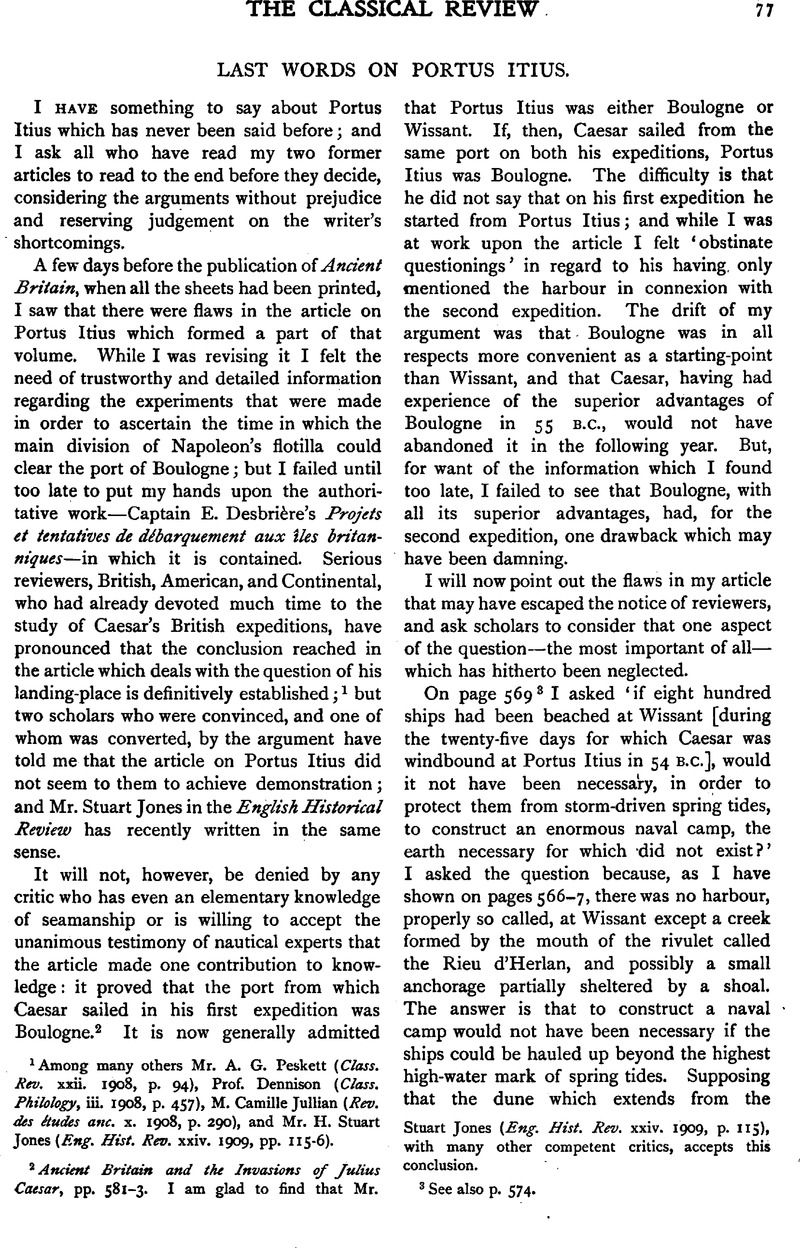No CrossRef data available.
Published online by Cambridge University Press: 27 October 2009

page 77 note 1 Among many others MrPeskett, A. G. (Class. Rev. xxii. 1908, p. 94)Google Scholar, ProfDennison, (Class. Philology, iii. 1908, p. 457)Google Scholar, Jullian, M. Camille (Rev. des études anc. x. 1908, p. 290)Google Scholar, and MrJones, H. Stuart (Eng. Hist. Rev. xxiv. 1909, pp. 115–116).CrossRefGoogle Scholar
page 77 note 2 Ancient Britain and the Invasions of Julius Caesar, pp. 581–3. I am glad to find that MrJones, Stuart (Eng. Hist. Rev. xxiv. 1909, p. 115), with many other competent critics, accepts this conclusion.CrossRefGoogle Scholar
page 77 note 3 See also p. 574.
page 78 note 1 Ancient Britain, etc., p. 566.
page 78 note 2 The eminent geologist, M. Charles Barrois, of the University of Lille, has very kindly written to me on this question. ‘Je ne crois pas,’ he says, ‘que nous ayons encore des documents assez précis pour arriver a une connaissance décisive et absolue de la question topographique qui vous interesse. Il faudrait pour cela faire une série de levées topographiques et de nivellements précis qui n/ont pu être faits encore.
‘Je ne puis done vous donner que mon impression que les conclusions de M. Gosselet [that the coast between Sangatte and Dunkirk extended considerably further seaward in Roman times than now (Ancient Britain, p. 566)] me paraissent appuyées sur des bases solides, qui n'ont pas été réfutées, et doivent entrainer l'assentiment, la côte s'étendant plus loin à l'époque romaine. … Je n'ai rien à ajouter à vos connaissances bibliographiques, qui me paraissent fort complètes.’
page 78 note 3 Cf. Stoffel, , Hist, de Jules César,—Guerre civile, ii. 110–111, and pl. 20.Google Scholar
page 78 note 4 Ancient Britain, etc., pp. 586–7. Cf. Boulognesur-mer et la région boulonnaise, i. 1899, p. 31.
page 78 note 5 Géogr. de la Gaule rom. i. 1876, pl. xv.
page 78 note 6 MrEvelyn-White, H. G. (Class. Rev. xxii. 1908, p. 205, n. 9)Google Scholar thinks that it ‘can probably be inferred [that Plautius started from Boulogne] from Suetonius, v. 17, ’—Quare a Massilia Gesoriacum usque pedestri itinere confecto inde [Claudius] transmisit, etc. But Claudius was not accompanied by an army; and it is questionable whether he would have started from Boulogne if he had had to get 800 ships out of the harbour.
page 79 note 1 Cf. B. G. iv. 23, § 2 with § 4.
page 79 note 2 M. Luchaire (Lavisse, E., Hist, de France, t. iii. ire partie, 1901, p. 162) appears sceptical as to the number.Google Scholar
page 79 note 3 Projets et tentatives, etc. iii. 1902, pp. 451, 566.
page 79 note 4 Ib. iv. 91, 94–5; iii. 141. Between the 1st of May and the 1st of November, 1804, more than 150 vessels were on three several occasions anchored in the roadstead for six or seven successive days; but on each occasion, when they were returning into the harbour, some of them were dispersed or injured (ib. iv. 145). Except in the very narrow space formed by the channel of the Liane, which at low water nowhere exceeded 40 metres in breadth and was in many places not more than 20, the ships were generally aground (ib. iii. pp. 147–8). The vessels of least draught could only cross the bar even at spring tides during 4 hours.
page 79 note 5 Ib. p. 144.
page 79 note 6 Some years ago I put the following question to Capt. J. Iron, the harbour-master of Dover:—‘It is certain that Boulogne harbour, that is, the estuary of the river Liane, was much larger in 54 B.C. than it is now. Assume that the harbour was about 2½ miles long, and that its breadth varied from 250 to 700 yards. [See A. E. E. Desjardins, Géogr. de la Gaule rom. vol. i. pl. xv.] Would it have been possible for 800 small vessels, which had oars as well as sails, and which drew not more than 3 feet of water, to get out of it in one tide?’ Capt. Iron's answer was, ‘Yes, because they would have had from one hour after to one hour before low water.’ But it is hardly safe to accept Desjardins's delineation of the harbour as absolutely accurate.
page 79 note 7 See the preceding note.
page 79 note 8 B.G. v. 8, § 2.
page 79 note 9 Ib. §§ 2, 5–6.
page 79 note 10 Ib. § 2.
page 80 note 1 B.G. iv. 23, § 6; B.C. i. 31, § 3; ii. 22, § 3; 25, § 7.
page 80 note 2 The ships were small, but comparatively broad; 540 of them carried 5 legions with their auxiliaries, camp equipage and stores, 2000 troopers, 2000 cavalry horses, remounts, and baggage cattle (B. G. v. 1, § 2; 2, § 2; 5, § 2; 8, §§ 1–2). Their breadth of beam cannot have been less than 15 feet and was probably rather more. The breadth of one of the great merchant-ships of the Mediterranean, the dimensions of which have been recorded by Lucian, was, as MrTorr, points out (Ancient Ships, 1894, p. 24)Google Scholar, ‘slightly more than a fourth of the length’; and Caesar says that the breadth of the ships which he designed was proportionally greater than that of the Mediterranean craft. The breadth of Napoleon's ‘bateaux canonniers,’ which were 60 feet long and drew only 4½ feet of water, was 14 feet (E. Desbrière, Projets et tentatives, etc. iii. 1902, p. 90). If Caesar's ships had all been moored in actual contact with one another (!), the line would have been over 4000 yards long.
page 81 note 1 Probably Labienus's camp was distinct from Caesar's; for if eight legions had occupied one camp, the three which Caesar left with Labienus when he sailed for Britain might have had difficulty in defending it.